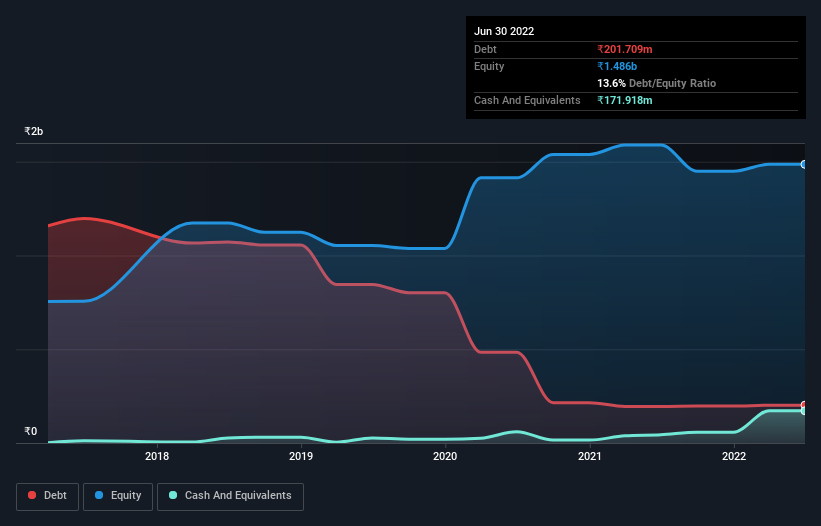Would Lasa Supergenerics (NSE:LASA) Be Better Off With Less Debt?

David Iben put it well when he said, 'Volatility is not a risk we care about. What we care about is avoiding the permanent loss of capital.' So it might be obvious that you need to consider debt, when you think about how risky any given stock is, because too much debt can sink a company. As with many other companies Lasa Supergenerics Limited (NSE:LASA) makes use of debt. But the real question is whether this debt is making the company risky.
What Risk Does Debt Bring?
Debt assists a business until the business has trouble paying it off, either with new capital or with free cash flow. If things get really bad, the lenders can take control of the business. However, a more usual (but still expensive) situation is where a company must dilute shareholders at a cheap share price simply to get debt under control. Of course, the upside of debt is that it often represents cheap capital, especially when it replaces dilution in a company with the ability to reinvest at high rates of return. The first step when considering a company's debt levels is to consider its cash and debt together.
View our latest analysis for Lasa Supergenerics
What Is Lasa Supergenerics's Debt?
As you can see below, Lasa Supergenerics had ₹201.7m of debt, at March 2022, which is about the same as the year before. You can click the chart for greater detail. On the flip side, it has ₹171.9m in cash leading to net debt of about ₹29.8m.

How Healthy Is Lasa Supergenerics' Balance Sheet?
We can see from the most recent balance sheet that Lasa Supergenerics had liabilities of ₹435.7m falling due within a year, and liabilities of ₹70.0m due beyond that. Offsetting this, it had ₹171.9m in cash and ₹185.4m in receivables that were due within 12 months. So it has liabilities totalling ₹148.4m more than its cash and near-term receivables, combined.
Since publicly traded Lasa Supergenerics shares are worth a total of ₹1.35b, it seems unlikely that this level of liabilities would be a major threat. But there are sufficient liabilities that we would certainly recommend shareholders continue to monitor the balance sheet, going forward. There's no doubt that we learn most about debt from the balance sheet. But you can't view debt in total isolation; since Lasa Supergenerics will need earnings to service that debt. So if you're keen to discover more about its earnings, it might be worth checking out this graph of its long term earnings trend.
Over 12 months, Lasa Supergenerics made a loss at the EBIT level, and saw its revenue drop to ₹1.3b, which is a fall of 29%. That makes us nervous, to say the least.
Caveat Emptor
While Lasa Supergenerics's falling revenue is about as heartwarming as a wet blanket, arguably its earnings before interest and tax (EBIT) loss is even less appealing. To be specific the EBIT loss came in at ₹107m. Considering that alongside the liabilities mentioned above does not give us much confidence that company should be using so much debt. Quite frankly we think the balance sheet is far from match-fit, although it could be improved with time. For example, we would not want to see a repeat of last year's loss of ₹183m. In the meantime, we consider the stock very risky. There's no doubt that we learn most about debt from the balance sheet. But ultimately, every company can contain risks that exist outside of the balance sheet. Case in point: We've spotted 3 warning signs for Lasa Supergenerics you should be aware of, and 1 of them is potentially serious.
If, after all that, you're more interested in a fast growing company with a rock-solid balance sheet, then check out our list of net cash growth stocks without delay.
New: AI Stock Screener & Alerts
Our new AI Stock Screener scans the market every day to uncover opportunities.
• Dividend Powerhouses (3%+ Yield)
• Undervalued Small Caps with Insider Buying
• High growth Tech and AI Companies
Or build your own from over 50 metrics.
Have feedback on this article? Concerned about the content? Get in touch with us directly. Alternatively, email editorial-team (at) simplywallst.com.
This article by Simply Wall St is general in nature. We provide commentary based on historical data and analyst forecasts only using an unbiased methodology and our articles are not intended to be financial advice. It does not constitute a recommendation to buy or sell any stock, and does not take account of your objectives, or your financial situation. We aim to bring you long-term focused analysis driven by fundamental data. Note that our analysis may not factor in the latest price-sensitive company announcements or qualitative material. Simply Wall St has no position in any stocks mentioned.
About NSEI:LASA
Lasa Supergenerics
Engages in the research, manufacture, and marketing of animal and human healthcare products in India.
Excellent balance sheet low.
Market Insights
Community Narratives



